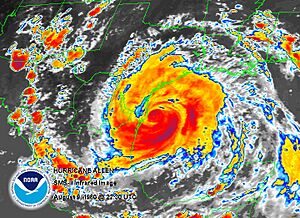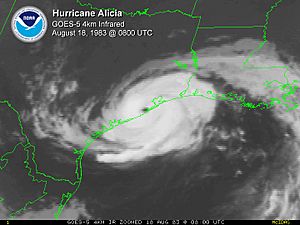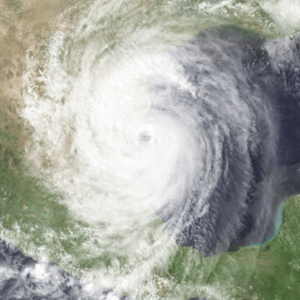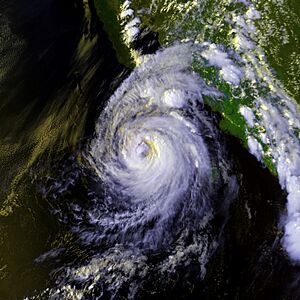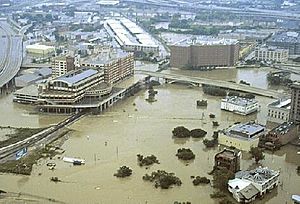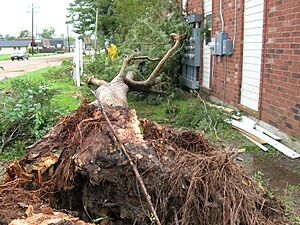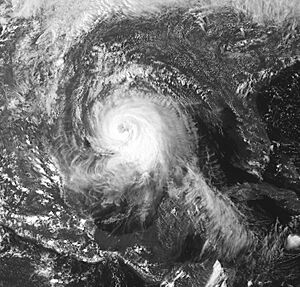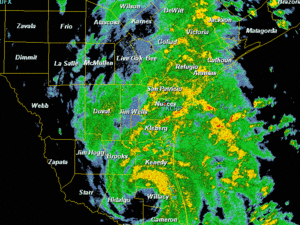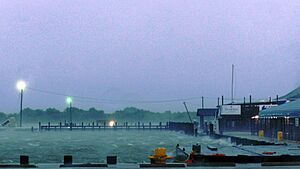List of Texas hurricanes (1980–present) facts for kids
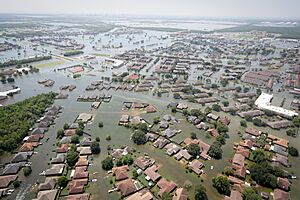
Since 1980, over 80 tropical storms and hurricanes have affected Texas. A tropical storm or hurricane usually hits the Texas coast about three times every four years. For any 50-mile (80 km) stretch of the coastline, a hurricane lands about once every six years.
September is the busiest month for these storms, with 21 recorded. No storms have hit Texas from December through May. Hurricane Allen in 1980 was the strongest in terms of pressure. However, Hurricane Harvey in 2017 caused the most deaths and damage. Harvey caused $125 billion in Texas alone. Hurricane Allen was the first storm in this period (August 1980). Hurricane Harvey on August 25, 2017, was the most recent. Harvey was also the strongest storm since 1980 based on wind speed. It had winds like a Category 4 hurricane on the Saffir–Simpson hurricane scale.
The 1980s saw many tropical storms and hurricanes. Six of them hit Texas as hurricanes, and three were major hurricanes. Hurricane Alicia was the most damaging hurricane of that time. It hit the Greater Houston area very hard. The names of the three major hurricanes from the 1980s were later retired. This means their names won't be used again for future storms. In the 1990s, only one hurricane, Hurricane Bret, hit Texas. The next decade saw five hurricanes make landfall. Hurricane Ike was the second most costly hurricane for Texas. Other important storms included Tropical Storm Allison and Hurricane Rita.
Contents
Storms from 1980 to 1984
- August 10, 1980 – Hurricane Allen hit near Brownsville as a strong Category 3 hurricane. Winds reached 140 mph (225 km/h) in Port Mansfield. Heavy rain fell across South Texas, with 20.2 inches (513 mm) in Kingsville. Most buildings on South Padre Island were destroyed. Allen also caused at least 12 tornadoes. One tornado damaged planes and hangars at Robert Mueller Municipal Airport, causing $250 million in damage. Two people drowned in the Corpus Christi area. Five others died indirectly. Allen caused about $600 million in damage.
- September 5, 1980 – Tropical Storm Danielle hit near Galveston Bay. It caused widespread flooding in Texas. Areas were swamped by rain, with 18.29 inches (465 mm) in Nederland. One person died because of Danielle's rains.
- Mid-November 1980 – Hurricane Jeanne stayed over the Western Gulf of Mexico. It caused tides to rise up to 4 feet (1.2 m) above normal along the Texas coast. Coastal flooding happened, especially near Galveston. Only minor damage was reported.
- Late-August 1981 – Tropical Depression Eight moved into Texas from Mexico. It brought very heavy rain to a 50-mile (80 km) wide area from Seguin to north of Houston. Cheapside received 18 inches (457 mm) of rain in 24 hours. Five people died in Shiner due to the heavy rains. Downtown Hallettsville had floods up to 5 feet (1.5 m) deep. Rivers like the Lavaca, Guadalupe, and Colorado also flooded. Damages from these floods were about $21 million.
- October 13, 1981 – Hurricane Norma hit Mexico's Pacific coast. Its leftover moisture caused 21 inches (533 mm) of rain near Dallas-Fort Worth, killing five people. Several tornadoes touched down in six counties, injuring three. Hurricane Norma caused $50 million in damage and killed three people in Texas.
- September 11, 1982 – Tropical Storm Chris hit near Sabine Pass. Before landfall, it caused tides 5 to 6 feet (1.5 to 1.8 m) high. Rain from Chris peaked at 0.96 inches (24 mm) in Evadale.
- August 18, 1983 – Hurricane Alicia hit near Galveston as a Category 3 hurricane. Alicia caused $2.6 billion in damage and 13 deaths. About 5,805 homes were badly damaged or destroyed. Oil rigs offshore were evacuated before Alicia. The entire city of Galveston lost power, and 250,000 homes in Houston also lost electricity. At the time, Hurricane Alicia was the most costly hurricane for Texas. Heavy rain fell across Southeast Texas, with 9.5 inches (241 mm) in Liberty. The strongest wind gust in Galveston was 102 mph (164 km/h). The storm surge in Galveston Bay was estimated at 12 feet (3.7 m). Alicia also caused 23 tornadoes, mostly around Galveston and Tyler.
- August 28, 1983 – Hurricane Barry, a Category 1 hurricane, hit just south of Brownsville. It caused 4,000 people to evacuate but only minor damage.
- Mid-October 1983 – The leftovers of Hurricane Tico from the Eastern Pacific caused rain across much of Texas. Northern Texas saw the most rain, with 9.59 inches (244 mm) in Quanah. Many roads closed due to floods from Tico's remnants. In Val Verde County, 100 people had to leave their homes. Tico's remnants killed one person and caused $93 million in damage.
- Mid-September 1984 – The leftovers of Tropical Storm Edouard caused severe flooding in South Texas. Some areas got over 20 inches (508 mm) of rain.
Storms from 1985 to 1989
- October 11, 1985 – The leftovers of Hurricane Waldo brought rain to most of West Texas. Many areas received at least 5 inches (127 mm) of rain.
- Late-October 1985 – Hurricane Juan dumped up to 10 inches (254 mm) of rain in extreme southeastern Texas. Alto saw 12.84 inches (326 mm). The rains caused widespread floods and road closures. Strong winds caused some power outages. Coastal flooding also happened due to high tides from Juan. One person died.
- June 26, 1986 – Hurricane Bonnie hit near High Island as a Category 1 hurricane. It killed four people in Texas. Heavy rain caused street flooding, with 13 inches (330 mm) in some areas. Bonnie also created four tornadoes in Texas.
- August 6, 1986 – A tropical depression brought rain to South Texas. Refugio received a maximum of 4.5 inches (114 mm).
- September 23, 1986 – The leftovers of Hurricane Newton brought 1 inch (25 mm) of rain to the Texas Panhandle. An area near the New Mexico border received 3 inches (76 mm), with 3.97 inches (101 mm) in Wharton.
- Early-October 1986 – The leftovers of Hurricane Paine caused widespread rain over western and northern Texas. Most areas got at least an inch of rain, with 10.39 inches (264 mm) in Wellington.
- October 22, 1986 – The leftovers of Hurricane Roslyn brought rain to much of southern and eastern Texas. The middle Texas coast saw the heaviest rain, over 10 inches (254 mm). Roslyn caused low-water crossings and streams to flood.
- August 10, 1987 – An unnamed tropical storm hit near High Island, Texas. It brought over 1 inch (25 mm) of rain to eastern parts of the state, with 4.25 inches (108 mm) in Umbarger.
- August 12, 1988 – Tropical Storm Beryl caused heavy rain in East Texas. Some areas received 11.8 inches (300 mm) of rain, leading to local flash flooding.
- September 2, 1988 – Tropical Depression Ten brought heavy rain to Southeast Texas, with 8.16 inches (207 mm) in Galveston.
- September 17, 1988 – Hurricane Gilbert hit northern Mexico with 135 mph (217 km/h) winds. It caused tides to rise up to 5 feet (1.5 m) above normal in Texas. This led to beach erosion on Padre Island. Rain peaked at 7.45 inches (189 mm) in Anson. Minor wind damage was reported. Twenty-nine tornadoes were recorded across Texas, with the worst damage in San Antonio. Gilbert caused three deaths in Texas, all from tornadoes in San Antonio. Damages from Gilbert totaled $50 million.
- Late-June 1989 – Tropical Storm Allison hit near Freeport, causing three deaths in the state. Allison brought huge amounts of rain, over 10 inches (254 mm) over much of the upper Texas coast. Orange saw 20.28 inches (515 mm). The storm surge in Trinity Bay was 7 feet (2.1 m). Beach erosion was reported on Padre Island. Allison caused an estimated $400 million in Texas alone.
- August 1, 1989 – Hurricane Chantal hit High Island, Texas, as a minimal hurricane. It caused two deaths from flash flooding.
- Early-October 1989 – Hurricane Raymond from the East Pacific caused rain in northern Texas, with 2.80 inches (71 mm) in Yorktown.
- October 16, 1989 – Hurricane Jerry affected the Galveston area as a minimal hurricane. The storm killed three people when a car was blown off The Galveston seawall. Jerry caused $70 million in damage and three deaths.
Storms from 1990 to 1994
- October 3, 1990 – Tropical Storm Rachel's leftovers affected parts of West Texas. Roads in Big Bend National Park closed due to high water. Rain peaked at 1.5 inches (38 mm) in Lubbock, causing minor street flooding and several car accidents.
- July 6, 1991 – Tropical Depression Two caused isolated rain over Texas. Anahuac reported a maximum of 3 inches (76 mm).
- August 24, 1992 – The leftovers of Hurricane Lester, from the East Pacific, caused rain in North Texas. Some areas got up to 3 inches (76 mm), with 3.54 inches (90 mm) in Chisos Basin.
- June 20, 1993 – Tropical Storm Arlene hit near Padre Island. Heavy beach erosion occurred. Arlene caused $55 million in damage and its flooding rains killed one person.
- September 14, 1993 – Hurricane Lidia moved into Texas before weakening near Austin. Lidia's leftovers caused moderate rain across the state, with 7.3 inches (185 mm) in Denton. The storm and a cold front caused tornadoes. One tornado caused over $8 million in damage. Five people were injured in Arlington when a hotel roof was torn off.
- Mid-October 1994 – The leftovers of Hurricane Rosa caused severe flooding in Texas. In some places, the flood was considered a "100-year event." Cypress saw 29.40 inches (747 mm) of rain. The floods killed 22 people and caused $700 million in damage.
Storms from 1995 to 1999
- July 31, 1995 – Tropical Storm Dean hit near Freeport. Dean dropped almost 17 inches (432 mm) of rain in Monroe City. This rainfall caused moderate local damage.
- August 12, 1995 – Tropical Storm Gabrielle hit just south of the Texas–Mexico border as a strong tropical storm. It brought rain to southern Texas, with 6.26 inches (159 mm) in Weslaco. A small storm surge from Gabrielle flooded beaches along the southern Texas coast.
- September 16, 1995 – Hurricane Ismael's leftovers moved across the Texas Panhandle. Rain peaked at 6.57 inches (167 mm) in Ransom Canyon, causing flash flooding in the area.
- August 23, 1996 – Hurricane Dolly hit near Tampico, Mexico. The storm brought helpful rain to drought-affected areas of southern Texas. Rain peaked at 5.53 inches (140 mm) in Corpus Christi, helping with the drought.
- October 4, 1996 – Tropical Storm Josephine formed just off the Texas coast. It brought heavy rain to the state, with 10.81 inches (275 mm) in Brownsville. The storm stayed offshore but caused severe beach erosion. Several houses were lost, and up to 65 feet (20 m) of shore-front property on Galveston Island eroded.
- August 23, 1998 – Tropical Storm Charley hit near Port Aransas. Severe inland flooding happened in Val Verde County, killing 13 people. Del Rio recorded 17 inches (432 mm) of rain in 24 hours, a city record. This was the most rain from a tropical storm in Texas since Tropical Storm Claudette in 1979.
- September 11, 1998 – Tropical Storm Frances hit north of Corpus Christi as a moderately strong tropical storm. Rain caused large amounts of flooding in southeast Texas and southwest Louisiana, with 21.76 inches (553 mm) in Goose Creek. Many rivers and bayous overflowed. Tides were 5 feet (1.5 m) above average. Frances caused an estimated $500 million in property damage.
- Mid-October 1998 – Moisture from the leftovers of Hurricane Madeline caused flooding in Central Texas. This event broke many rain records, including the wettest month for San Antonio since 1885. Also, 15 rivers had their highest water levels ever recorded. The floods killed 31 people and caused $1.5 billion in damage.
- August 23, 1999 – Hurricane Bret hit Padre Island as a Category 3 hurricane. It was the first major hurricane to hit Texas since Hurricane Alicia in 1983. As it approached, large waves caused minor beach erosion. Beaches in Matagorda County closed due to high water. Further inland, heavy rain fell across South Texas, reaching 13.18 inches (335 mm) in Sarita. At the storm's peak, about 64,000 customers lost power. Because Bret was small and hit a less populated area, damages were only $15 million. However, it caused four deaths, all from a semi-trailer truck jackknifing in Laredo.
- September 8, 1999 – Tropical Depression Seven's leftovers brought light rain, with 3.35 inches (85 mm) in Harlingen.
Storms from 2000 to 2004
- September 9, 2000 – Tropical Depression Nine hit near Sabine Pass with 30 mph (48 km/h) winds. Only minor damage was reported.
- June 5, 2001 – Tropical Storm Allison hit near Freeport. It stayed over eastern Texas for several days, dropping extreme amounts of rain. This led to terrible flooding. Allison caused flash flooding, widespread street flooding, and filled nearby bayous to dangerous levels. Rain peaked at 36.99 inches (940 mm) at the Port of Houston. The Texas Medical Center was severely damaged, with losses up to $2 billion. Patients had to be moved, and medical services were stopped due to power outages. Allison caused an estimated $4.8 billion in damage, mostly from freshwater flooding in the Greater Houston area. Tropical Storm Allison caused 23 deaths in the state. It was the only non-hurricane strength storm to have its name retired until Tropical Storm Erika in 2015.
- August 9, 2002 – Tropical Storm Bertha hit as a tropical depression near Kingsville. It caused isolated rain throughout the state.
- September 7, 2002 – Tropical Storm Fay hit near Port O'Connor. It caused heavy rain and $450,000 in damage. Rain peaked at 18.49 inches (470 mm) in Fowlerton. Fay caused five tornadoes, one of which injured three people. Much of the damage was in Brazoria County, where over 2,300 homes were damaged.
- June 30, 2003 – Tropical Storm Bill caused minor beach erosion on the Bolivar Peninsula.
- July 15, 2003 – Hurricane Claudette hit Matagorda Island near Port O'Connor as a strong Category 1 storm, with 90 mph (145 km/h) winds. Claudette caused one direct death. Inland towns in Texas had significant wind damage. Estimated damages totaled up to $180 million.
- August 16, 2003 – Hurricane Erika hit the Mexican state of Tamaulipas as a minor Category 1 hurricane. It caused minor coastal damage and beach erosion in parts of southern Texas.
- August 31, 2003 – Tropical Storm Grace hit near San Luis Pass with 40 mph (64 km/h) winds. It caused heavy rain along the Texas coast, resulting in $113,000 in total damages.
- September 22, 2003 – Hurricane Marty from the East Pacific hit Mexico. Rain from Marty's leftovers affected western Texas.
- September 20, 2004 – As the leftovers of Hurricane Javier moved through northwest Mexico, 1 inch (25 mm) of rain was reported in western Texas.
- September 24, 2004 – Four days after Hurricane Javier, Hurricane Ivan, which had become a tropical storm again, hit near Cameron, Louisiana, as a tropical depression. Over 7 inches (178 mm) of rain fell on eastern Texas.
- October 10, 2004 – Tropical Storm Matthew moved ashore in southern Louisiana. It caused heavy rain in eastern Texas, with 6.10 inches (155 mm) in Matagorda, but little damage.
Storms from 2005 to 2009
- July 20, 2005 – Hurricane Emily hit Tamaulipas, Mexico. It brought rain to drought-affected areas of southern Texas. Rain peaked at 5.2 inches (132 mm) in Mercedes. Other areas received 1 to 3 inches (25 to 76 mm).
- September 23, 2005 – Hurricane Rita hit as a Category 3 hurricane on the border between Louisiana and Texas. Before it hit, the largest evacuation in United States history happened, with over 3 million people moving inland. At one point, 1 million power customers lost electricity. Rita caused 10.48 inches (266 mm) of rain in Center. Major flooding was reported in Port Arthur and Beaumont. Offshore oil platforms were also badly damaged. Many indirect deaths from Rita were caused by a bus fire during the mass evacuations from Houston. Rita caused 59 deaths in the state.
- September 2, 2006 – The leftovers of Hurricane John, an East Pacific storm, caused moderate to heavy rain. In northern Texas, moisture from the storm combined with a cold front brought over 4 inches (102 mm) of rain, helping with a severe drought.
- September 16, 2006 – Hurricane Lane, another East Pacific storm, hit Mexico. Lane's leftovers combined with a weather system over southeast Texas, dropping over 5 inches (127 mm) of rain in some places.
- August 16, 2007 – Tropical Storm Erin hit near Lamar as a minimal tropical storm. Rain peaked in Texas at 10.7 inches (272 mm) in Sisterdale. Erin caused nine deaths in the state and nearly $49 million in damage.
- September 13, 2007 – Hurricane Humberto quickly grew stronger before hitting just west of the Louisiana–Texas border with winds up to 90 mph (145 km/h). It dropped up to 14.13 inches (359 mm) of rain. The storm killed one person and caused $50 million in damage.
- July 23, 2008 – Hurricane Dolly hit South Padre Island with winds near 100 mph (161 km/h). A storm surge of 4 feet (1.2 m) was seen along much of the southern Texas coast. Dolly's leftovers caused coastal and inland flooding and over 12 inches (305 mm) of rain in some places, with 15 inches (381 mm) in Harlingen. On South Padre Island, moderate damage, mostly to roofs, was reported. Trees and utility poles were widely damaged in Cameron County. Widespread power outages happened across southern Texas because of Dolly.
- August 5, 2008 – Tropical Storm Edouard hit near Port Arthur with winds near 65 mph (105 km/h). Edouard brought helpful rain to central Texas, which was suffering from drought.
- September 1, 2008 – Hurricane Gustav brought heavy rain to extreme East Texas as it hit Louisiana as a Category 2 hurricane. The storm caused strong rip currents and minor overwash on the coast.
- September 13, 2008 – Hurricane Ike hit Galveston as a large Category 2 hurricane. Its large size caused a storm surge as high as 20 feet (6.1 m). This flooded many of the barrier islands off the Texas coast. Many buildings on the Bolivar Peninsula were destroyed. In Gilchrist, all but one house was destroyed by the storm surge. The storm also caused heavy rains where it hit, with 18.9 inches (480 mm). At one point, the storm knocked out power for an estimated 2.6 million people. Ike was one of the most damaging hurricanes to hit Texas and one of the deadliest. It caused $19.3 billion in damage and killed 84 people.
- October 13, 2008 – Hurricane Norbert caused moderate rain over West Texas after moving inland from the eastern Pacific.
- November 10, 2009 – Hurricane Ida had minimal effects on Texas. It caused high tides that led to road closures.
Storms from 2010 to 2014
- June 30, 2010 – Hurricane Alex hit Mexico as a large Category 2 hurricane. It brought heavy rains, wind, and tornadoes to South Texas. The hurricane's leftovers also brought heavy rains to parts of the Rio Grande, causing it to reach record levels.
- July 8, 2010 – Tropical Depression Two hit South Padre Island. It dropped 1 to 3 inches (25 to 76 mm) of rain in south Texas, with 8.95 inches (227 mm) in Chincorro. However, no significant damage was reported.
- September 7, 2010 – Tropical Storm Hermine hit northeastern Mexico as a strong tropical storm with 65 mph (105 km/h) winds. A storm surge of 3.4 feet (1.0 m) was reported at Port Aransas. In the Rio Grande Valley, about 35,000 homes lost power. In Bexar County, 100,000 customers lost power. Farm crops in the Texas Coastal Bend were damaged by strong winds and rain. Many roads closed due to flooding. Hermine killed five people and caused $240 million in damage in the state.
- June 30, 2011 – Tropical Storm Arlene hit south of Texas near Cabo Rojo. Its outer bands brought 1 to 4 inches (25 to 102 mm) of rain to southern Texas.
- July 30, 2011 – Tropical Storm Don hit near Baffin Bay, Texas, and quickly weakened. The storm brought minimal rain to extreme southern Texas, with 2.56 inches (65 mm) in Bay City. Cotton farms benefited from the small amount of rain.
- Early-September 2011 – The outer bands of Tropical Storm Lee caused light rain in eastern Texas, with 3.97 inches (101 mm) in Nederland. Despite the light rain, strong winds further inland helped start many wildfires. One fire, the Bastrop County Complex fire, destroyed 1,700 homes and businesses. It became the most destructive wildfire in Texas history.
- August 31, 2012 – Outer rainbands from Hurricane Isaac caused slight rain in East Texas, about 3 inches (7.6 cm) near Galveston Bay. Strong winds from Isaac's thunderstorms knocked down many trees in Trinity County. Wind gusts reached an estimated 65 mph (105 km/h).
- September 29, 2012 – Moisture from the leftovers of Hurricane Miriam and Tropical Storm Norman brought light rain over parts of Texas. This helped with drought conditions. Rain in the state was 1 to 4 inches (25 to 102 mm), causing some flash flooding. This moisture, combined with another weather system, created severe thunderstorms. These storms later formed a squall line, bringing strong winds that damaged many windows. A weather station near Paducah recorded a peak wind gust of 96 mph (154 km/h).
- Mid-September 2013 – As Hurricane Ingrid passed to the south, its outer rainbands dropped isolated heavy rain across South Texas. Rain totals peaked at about 3 inches (76 mm) near the Texas border with Mexico.
- September 3, 2014 – Even though Tropical Storm Dolly hit near Tampico, Mexico, its outer rainbands moved across South Texas. They produced rain totals peaking at 2.91 inches (74 mm) in Hidalgo County. After the storm weakened, its leftover moisture caused more showers. Urban flooding happened in Brownsville, Edinburg, and McAllen due to poor drainage. However, the heavy rain helped ease some drought conditions in South Texas.
- September 20, 2014 – Flooding from the leftovers of Hurricane Odile killed one sheriff's deputy in Austin.
Storms from 2015 to 2019
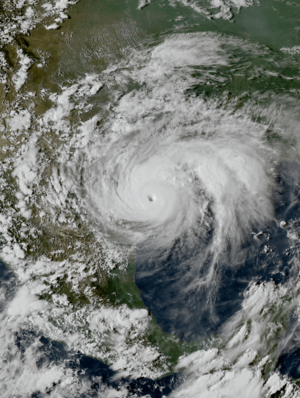
- Mid-June 2015 – Tropical Storm Bill hit Matagorda Island with 60 mph (97 km/h) winds. Gusts reached 53 mph (85 km/h) in Palacios and Port O'Connor. It also caused a 3 ft (0.9 m) storm surge in Port Lavaca. However, most of Bill's impact in Texas was from heavy rain. Several areas received over 10 inches (25 cm) of rain, including a large part of Victoria County. In Wharton, rain peaked at 13.05 inches (331 mm).
- October 20–24, 2015 – Hurricane Patricia's leftovers brought heavy rain to Texas. The highest rainfall was 20.87 inches (530 mm) in Corsicana. This rain caused flooding and closed Interstate 45 in that area.
- September 8, 2016 – The leftovers of Hurricane Newton brought heavy rains to parts of western Texas. No significant damage was reported.
- June 22, 2017 – Tropical Storm Cindy hit near Port Arthur with 45 mph (72 km/h) winds. One person died in Bolivar Peninsula.
- Late August 2017 – Hurricane Harvey hit San José Island near Rockport as a Category 4 hurricane on August 26. Winds reached 130 mph (209 km/h). The Aransas County Airport in Rockport recorded a 145 mph (233 km/h) wind gust. Extensive wind damage happened in Rockport and Fulton. Many roofs were blown off, and walls torn apart. Nearby communities also saw widespread damage. Storm surge flooded areas along San Antonio and Hynes bays with 8 to 10 ft (2.4 to 3.0 m) of water, causing major floods. Harvey moved slowly along the Texas Coastal Plain for several days. This caused long, heavy rainfall from its rainbands. The rains were the most intense ever from a tropical storm in U.S. history. The peak rainfall was 60.58 inches (1,539 mm) near Nederland. This set a national record for tropical cyclone rainfall. At least 18 locations reported more rain than the previous U.S. record of 48 inches (1,219 mm). This huge amount of rain caused catastrophic flooding. About 1.8 million people had to leave their homes. Bayous in the Greater Houston area quickly rose and overflowed. This led to evacuations and submerged parts of Houston. 60,049 residents were rescued. Parts of all 22 major highways in the Houston area were flooded. Tens of thousands of homes in Southeast Texas were flooded. In total, Harvey destroyed 16,930 homes and damaged 290,063 homes. At least 68 deaths were directly caused by Harvey. An additional 35 deaths were indirectly caused by the storm. The NOAA estimates Harvey caused $125 billion in damage. This makes it the second costliest hurricane in U.S. history and the costliest in Texas history.
- September 17–19, 2019 – Tropical Storm Imelda hit near Freeport, Texas with 40 mph (64 km/h) winds. The storm moved slowly and unpredictably. This caused widespread and catastrophic flooding across much of southeastern Texas. A peak rainfall of 43.39 inches (1,102 mm) was recorded at North Fork Taylor's Bayou in Jefferson County. Imelda killed five people.
Storms from 2020 to Present
- July 25, 2020 – Hurricane Hanna hit about 12 miles (19 km) north-northwest of Port Mansfield with 90 mph (145 km/h) winds. Texas had over $1.1 billion in damage. Crops in the Rio Grande Valley suffered heavy losses. Widespread power outages affected about 200,000 people. Five indirect deaths were linked to the storm, including four from carbon monoxide poisoning in Edinburg. Rainfall was 6 to 12 inches (152 to 305 mm) across the Rio Grande Valley, with a peak of 15.49 inches (393 mm) near Santa Rosa. The heavy rains caused flash floods and required water rescues in Hidalgo and Cameron counties.
- August 26, 2020 – The western part of Hurricane Laura impacted southeast Texas. It brought 60 to 110 mph (97 to 177 km/h) wind gusts. Orange was hit hardest. More than 160,000 power customers lost electricity. About 90 percent of Orange County lost power. Six people died from carbon monoxide poisoning after Laura. An additional 18 people were treated for carbon monoxide injuries.
- Mid-September 2020 – The slow-moving Tropical Storm Beta caused extensive rain across southeast Texas. A station in Brookside recorded a peak of 15.77 inches (401 mm). Significant flooding happened in southern Houston. At least 20–25 homes were damaged. One person drowned in Brays Bayou.
- October 9, 2020 – Hurricane Delta hit near Creole, Louisiana, as a Category 2 hurricane. Hurricane-force winds reached west into Southeast Texas. The Southeast Texas Regional Airport recorded a peak gust of 90 mph (145 km/h). About 5 to 10 inches (127 to 254 mm) of rain fell over the region. Power outages affected over 100,000 power customers in Southeast Texas. Waves from Delta caused some beach erosion and coastal flooding along the Texas coast.
- September 14, 2021 – The slow-moving Hurricane Nicholas hit the eastern part of Matagorda Peninsula as a low-end Category 1 hurricane with 75 mph (121 km/h) winds. Over 500,000 people lost power in the affected areas of the state. Measured rainfall peaked at 10.19 inches (259 mm) in Freeport. However, the National Weather Service estimated 10 to 15 inches (254 to 381 mm) near Galveston. The damage from Nicholas was most significant in Brazoria and Matagorda counties. Almost all homes in Surfside Beach were damaged.
- August 22, 2023 – Tropical Storm Harold hit Padre Island with estimated 50 mph (80 km/h) winds. Wind gusts reached 67 mph (108 km/h) in Loyola Beach and 65 mph (105 km/h) in Corpus Christi. About 20,000 electricity customers lost power in Texas. This included over 12,000 American Electric Power outages in Corpus Christi. Roughly 7 inches (178 mm) of rain fell on Mustang Island east of Corpus Christi.
Monthly Storm Activity
| Month | Number of storms |
|---|---|
| June |
8
|
| July |
7
|
| August |
20
|
| September |
25
|
| October |
13
|
| November |
2
|
Deadliest Storms in Texas
This table lists tropical storms and hurricanes that caused deaths in Texas.
| Name | Year | Number of deaths | Notes |
|---|---|---|---|
| Harvey | 2017 | 103 | |
| Ike | 2008 | 84 | |
| Rita | 2005 | 59 | |
| Allison | 2001 | 23 | |
| Alicia | 1983 | 13 | |
| Charley | 1998 | 13 | |
| Erin | 2007 | 9 | |
| Laura | 2020 | 9 | |
| Allen | 1980 | 7 | |
| Eight | 1981 | 5 | |
| Norma | 1981 | 5 | |
| Hermine | 2010 | 5 | |
| Imelda | 2019 | 5 | |
| Bonnie | 1986 | 4 | |
| Bret | 1999 | 4 | |
| Allison | 1989 | 3 | |
| Jerry | 1989 | 3 | |
| Chantal | 1989 | 2 |
More About Storms
- Atlantic hurricane season
- List of Atlantic hurricanes
- List of Pacific hurricanes
- List of wettest known tropical cyclones affecting Texas


